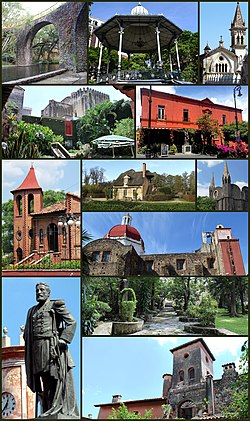
Back كويرنافاكا Arabic Kuernavaka Azerbaijani Куэрнавака Byelorussian Куернавака Bulgarian Cuernavaca Catalan Cuernavaca (kapital sa estado) CEB کوێرناڤاکا CKB Cuernavaca Danish Cuernavaca German Κουερναβάκα Greek
Cuernavaca
Cuauhnāhuac | |
|---|---|
City and municipality | |
 From top, left to right: Train bridge in the Chapultepec Ecological Park, Kiosk in Jardín Juárez, Chapel of Our Lady of Mount Carmel, Inner courtyard of the Robert Brady Museum, Restaurant Alondra (Historic Center), El Castillito, Side facade of the entrance to Villa Cuauhnáhuac, Chapitel del Calvario, View of the dome of the Parish of Our Lady of Guadalupe, General Carlos Pacheco Villalobos Monument, Borda Garden, Tower of the Robert Brady Museum | |
| Nickname: "City of Eternal Spring" | |
| Coordinates: 18°55′07″N 99°14′03″W / 18.91861°N 99.23417°W | |
| Country | |
| State | Morelos |
| Founded | 1714 |
| Municipal Status | 1821 |
| Government | |
| • Mayor | José Luis Urióstegui (PAN) |
| Area | |
| • Municipality | 151.2 km2 (58.4 sq mi) |
| Elevation (of seat) | 1,510 m (4,950 ft) |
| Population (2015[1]) Municipality | |
| • Municipality | 366,321 |
| • Seat | 332,197 |
| GDP (PPP, constant 2015 values) | |
| • Year | 2023 |
| • Total | $19.0 billion[2] |
| Time zone | UTC−6 (CST) |
| • Summer (DST) | UTC−5 (CDT) |
| Postal code (of seat) | 62000 |
| Area code | 777 |
| Website | (in Spanish) www |
Cuernavaca (Spanish pronunciation: [kweɾnaˈβaka] ; Classical Nahuatl: Cuauhnāhuac [kʷawˈnaːwak], "near the woods" , Otomi: Ñu'iza) is the capital and largest city of the state of Morelos in Mexico. Along with Chalcaltzingo, it is likely one of the origins of the Mesoamerican civilization. Olmec works of art, currently displayed in the Museum of Anthropology in Mexico City were found in the Gualupita III archeological site.
The city is located south of Mexico City and reached via a 90-minute drive using the Federal Highway 95D.[3]
The name Cuernavaca is a euphonism derived from the Nahuatl toponym Cuauhnāhuac and means 'surrounded by or close to trees'. The name was Hispanicized to Cuernavaca; Hernán Cortés called it Coadnabaced in his letters to Charles V, Holy Roman Emperor, and Bernal Díaz del Castillo used the name Cuautlavaca in his chronicles.[4] The coat-of-arms of the municipality is based on the pre-Columbian pictograph emblem of the city that depicts a tree trunk (cuahuitl) with three branches, with foliage, and four roots colored red. There is a cut in the trunk in the form of a mouth, from which emerges a speech scroll, probably representing the language Nahuatl and by extension the locative suffix -nāhuac, meaning 'near'.[5]
Cuernavaca has long been a favorite escape for Mexico City residents and foreign visitors because of its warm, stable climate and abundant vegetation. The municipality was designated a Forest Protection Zone by President Lázaro Cárdenas in 1937 to protect the aquifers, the vegetation, and the quality of life of residents, both in Mexico City and locally.[6] The city was nicknamed the "City of Eternal Spring" by Alexander von Humboldt in the 19th century.[7] Aztec emperors had summer residences there, and considering its location of just a 1½-hour drive from Mexico City, today many Mexico City residents maintain homes there.[8] Cuernavaca is also host to a large foreign resident population, including large numbers of students who come to study the Spanish language.[9]
- ^ http://cuentame.inegi.org.mx/monografias/informacion/mor/poblacion/ Archived 4 August 2022 at the Wayback Machine Retrieved Dee 18, 2018.
- ^ "TelluBase—Mexico Fact Sheet (Tellusant Public Service Series)" (PDF). Tellusant. Archived (PDF) from the original on 13 January 2024. Retrieved 11 January 2024.
- ^ Wright, Anthony (17 April 2009). "In Morelos, Cuernavaca springs eternal". MexConnect. Archived from the original on 23 March 2019. Retrieved 28 September 2009.
- ^ "Estos 11 nombres Mexicanos surgiegeron por malentendidos entre los Españoles y los y los pueblos Mesoamericanos" [These 11 names came from misunderstandings between the Spanish and the Mesoamerican peoples]. El País (in Spanish). 28 March 2017. Archived from the original on 31 December 2018. Retrieved 30 December 2018.
- ^ "Enciclopedia de los Municipios de México ESTADO DE MORELOS CUERNAVACA" (in Spanish). Archived from the original on 19 November 2008. Retrieved 28 September 2009.
- ^ "Acuerdo por el que se declara el área natural protegida denominada "Bosque Mirador"" [Agreement declaring the protected natural area called "Bosque Mirador"] (PDF). City of Cuernavaca. Archived from the original (PDF) on 31 December 2018. Retrieved 30 December 2018.
- ^ Kastelein, Barbara (November 2006). "Cuernavaca: la verdadera historia de su eterna primavera" [Cuernavaca: The true story of its eternal spring]. Revista Travesias. Mexico City. Archived from the original on 20 September 2009. Retrieved 28 September 2009.
- ^ "Cuernavaca, Mexico Caminando sin rumbo" [Cuernavaca, Mexico: Wandering aimlessly]. Caminando sin Rumbo (in Spanish). July 2006. Archived from the original on 22 March 2016. Retrieved 28 September 2009.
- ^ Morse, Emily. "Cuernavaca, Mexico: The Perfect Place to Study Spanish". Archived from the original on 31 January 2013. Retrieved 28 September 2009.



